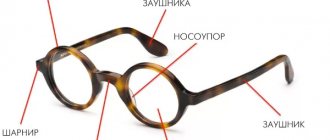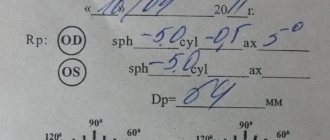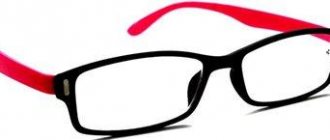Many people, when buying glasses, are faced with the question “How to determine the size of glasses” and where to get information about the size of glasses.
The manufacturer often indicates information about the size of its products on the inside of the bow. In some cases, the size of the glasses is indicated on the bridge connecting the lenses. And sometimes the manufacturer only indicates the size information on the packaging, but such cases are not that common. Sometimes the markings on glasses are spaced out, some of the numbers are placed on the temple, and some on the bridge.
Let’s choose this model of glasses as a visual example; it has a wide temple with easy-to-read size numbers.
How to find out your sunglasses size
You can find the size markings of any glasses on the inside of the left temple. Usually it is written there after the brand name in the form of three numbers (sometimes four), separated by dots, dashes, slashes or squares. For example: 58–18–140. Let's look at what each of these parameters means:
- the first number (58) is the width of the lens;
- the second number (18) is the width of the distance (bridge) between the lenses;
- the third number (140) is the length of the temple.
The main dimensional parameters of glasses: lens width, distance between lenses and arm length
All dimensions are written in millimeters. If four numbers are indicated at once, then the last one shows the width of the frame. This marking helps you determine almost accurately whether glasses are suitable for you or not.
The size of glasses can be written not only on the temple, but also on the bridge of the nose. Some manufacturers indicate the size only on the packaging.
Standard lens sizes for sunglasses
With so many styles of sunglasses out there, it may seem like there are a lot of different lens sizes to choose from. In fact, this is not so, and choosing the right parameters will not be a big problem, even without trying on the accessory. Standard widths for sunglass lenses range from 54 to 62 mm.
- 54–55 mm - lenses of this width are suitable for teenagers and people with narrow faces;
- 58 mm is the most common size, it is universal and fits the vast majority of people;
- 60–62 mm is a size that is well suited for people with wide faces and lovers of large, chunky frames.
Lenses in popular sunglasses have a standard lens width of 54 mm to 62 mm
These are the standard sizes of the most common sunglasses models. For models of a specific design (“chanterelles”, “triangles”), the width of the lenses may differ slightly from the standard.
Determining the width of the frame
Some manufacturers also prescribe the overall width of the frame, but more often you have to determine it yourself. This is not difficult to do. You need to multiply the lens width parameter by 2, add the width of the bridge (the second size in the marking) and add about 10 mm to the hinges to which the arms are attached. This will tell you the width of your glasses frame.
If we consider our example, the calculation will be as follows: 58 * 2 + 18 + 10 = 144 mm. The frame width of our glasses is 144 mm.
Shape of glasses
The choice of glasses shape is a purely individual matter. Everyone has the right to decide for themselves what suits them and what doesn’t. However, there are practical tips that are worth remembering. The main point when choosing the shape of glasses is the shape of the face. The classical canons look like this:
- For those with round faces, rectangular or square frames are more suitable.
- The oval face shape is considered universal; most frames will fit here.
- For those with a triangular face shape, it is preferable to go for rectangular frames.
- square and rectangular shapes are most organically combined with round or oval frames.
The classic aviator and wayfarer glasses are suitable for everyone in the vast majority of cases.
The official website Ray-Ban.com can greatly help you in virtually selecting the appropriate shape of glasses. It is here that, using the “Virtual Mirror” tool, you can put any shape of glasses on your face (namely, your own, using a webcam), and choose the color of the lenses and frames.
Determining your ideal glasses size
To independently calculate the optimal size of glasses, you will need to calculate the most important parameter - the width of your face. Algorithm of actions:
- Stand in front of a mirror and put a pencil to your ears. These are the starting points.
- Use a ruler to measure the distance between the pencils. The resulting figure will show the desired width of the face.
- When choosing glasses, make sure that the width of the frame does not differ from the actual width of your face by more than 2–3 mm.
The width of the glasses frame is determined by the outer frame
You can find out the required frame width by simply measuring it using old glasses of the appropriate size. It is measured from the outside of the accessory and usually varies from 120 mm to 150 mm. You can also determine the correct frame size by measuring the distance between your temples at the height of the bridge of your nose.
size table
Table 1. Rectangular glasses
| Size | Height (mm) | Bridge (mm) | Shackle (mm) |
| 47 | 38 | 22 | 145 |
| 49 | 42 | 21 | 140 |
| 50 | 40 | 22 | 150 |
| 51 | 44 | 21 | 145 |
| 52 | 36 | 18 | 145 |
| 54 | 47 | 18 | 150 |
| 55 | 40 | 18 | 145 |
Table 2. Drop-shaped glasses
| Size | Height (mm) | Width (mm) | Shackle (mm) |
| 55 | 47 | 132 | 135 |
| 58 | 49 | 138 | 135 |
| 62 | 55 | 148 | 140 |
Table 3. Round glasses
| Size | Height (mm) | Bridge (mm) | Shackle (mm) |
| 40 | 36.2 | 21 | 120 |
| 47 | 44 | 20 | 140 |
| 49 | 46.8 | 21 | 145 |
| 50 | 46.9 | 21 | 145 |
| 52 | 49 | 21 | 145 |
| 53 | 50 | 20 | 140 |
| 55 | 50.4 | 21 | 135 |
| 56 | 51.5 | 19 | 140 |
Expert opinions on choosing sunglasses
What do experts think about choosing your own glasses? Where, according to ophthalmologists, is it better to buy sunglasses and what else should you pay attention to when buying, besides size? We found several interesting expert opinions on this matter.
An optical salon is a licensed professional institution that cooperates with manufacturers who guarantee the quality of their products. In this case, all parameters of the lenses are reliably known - light transmission, filter, etc. The optics will not sell fakes. And when buying sunglasses somewhere else, we don’t know what we’re getting or what kind of pig is in the poke.
It is important that glasses are selected correctly individually, which can only be done by an optician. He will take into account the characteristics of the glasses, the conditions under which they will be used, and the needs of the person.
Ophthalmologist Lidiya Sergeevna Chumachenko
https://teleprogramma.pro/shopping/223369/
The most important rule is not to focus on price. It depends not on the quality of the lenses or the comfort of the frames, but on the latest fashion trends. If your choice is branded glasses, please note that serious companies, concerned about their reputation, duplicate the name and collection number not only on the label, but also on the inside of the temple of the glasses, also in the corner of the lens. The label should contain information about the degree of protection of the glasses from ultraviolet radiation.
Ophthalmologist, Candidate of Medical Sciences Maria Zenina
https://www.aif.ru/health/secrets/34297
Before choosing, first consult with an ophthalmologist, and only then order or buy sunglasses with diopters. Otherwise, you risk deteriorating your vision. I would also advise, in order to eliminate uncomfortable effects (formation of “holes” under the feet, disorientation), to select a model of sunglasses with a flatter shape, reaching forms where the lenses are located in the same plane in front of the eyes, like optical glasses. And, finally, it is advisable to buy glasses where you can see a hygiene certificate with the original seal of the supplier, which the seller must have.
Ophthalmologist Yuri Anatolyevich Rodenko
https://doctor.by/ainmenu-117/1265-mnenie-oftalmologa-pri-vybore-solncezashhitnyh-ochkov
What experts advise you to pay attention to when choosing sunglasses: video
How to choose glasses using size charts
On online store websites, in the descriptions of glasses, you can most often see tables with sizes for each model. They usually contain all the parameters mentioned above: the width of the lenses, the distance between the glasses, the length of the temple. You already know how to use them to calculate the width of the frame and choose the one that suits you.
Sometimes sellers immediately indicate the width and height of the frame in the table. In this case, making the right choice is much easier. Focus on your facial width, calculated using the algorithm above. Or just go to the nearest optician or store, try on several models and write down the parameters of glasses that are ideal for your size. Now you can safely choose and place an order in the online store.
You can choose the size of glasses with an optician with a specialist and then order a suitable model in the online store
How to choose your glasses size?
When choosing a specific model, you need to consider the width:
- glasses with a rim, or the distance between the outer edges of the glasses;
- lenses;
- bridge on the bridge of the nose.
Another important parameter is the length of the temple. Glasses sizes are usually marked on the inside left side of optical products. Notice the three numbers separated by dashes. Suppose the following data is indicated on the earhook: “50-20-138”. The first number is the width of the lens, the second is the bridge on the bridge of the nose, the third is the length of the temple. The marking may be slightly different. It depends on the manufacturer. Sometimes 4 numbers are indicated, one of which is the height of the frame. All these indicators are expressed in millimeters. These measurements do not indicate the face or head size for which the glasses are intended. However, it is not so difficult to calculate it yourself.
It is necessary to multiply 50 mm by 2, since there are two lenses, and add the width of the bridge. It turns out that the total width is 120 mm. To this value you can add about 1 more centimeter, which falls on the hinge joints. Thus, these glasses are suitable for a person with a face of 130 mm. This indicator represents the distance from one temple to another from the side of the eyes. You can measure it yourself using a ruler. You should measure with a small margin, since size 50 is the width of the lens without the rim.
It may protrude a few more millimeters. There are models of glasses optics in the hypersize or “cat’s eye” style, which are much wider than a person’s face.
Now you know what frame size means. What happens if the characteristics indicated on it slightly do not correspond to the size of the face or the indicators indicated on your old optics? Does all this data have to match perfectly?
How to identify an accessory of the wrong size
The correct size of glasses is the key to wearing them comfortably. If the size is determined incorrectly, you will inevitably encounter inconvenience.
- A feeling of tightness in the temporal area is an indicator that the frames are too narrow; the glasses are too small for you.
- Glasses regularly fall or slide to the side at the slightest movement - this means that the frames, on the contrary, are too wide.
- A feeling of tightness in the bridge of the nose indicates that the temples are not long enough or that the model is designed for those with narrow faces.
Glasses of the wrong size can cause migraines and blurred vision.
How to correctly determine the size of your glasses frame?
The frame parameters should almost completely correspond to the size of the face and head. Why is this so important? Externally, almost all glasses seem approximately the same. For example, children's and adult frames are very different from each other. But any optical products, both sun protection and corrective, are selected not only according to the shape of the face. The aesthetic factor, of course, is very important, because glasses are not just a means of correction, but an accessory that should be in harmony with the entire image. But this factor cannot be called determining.
What happens if the frame sizes are determined incorrectly? These glasses look ugly. But this is only part of the problem. Frames that are too narrow put pressure on the bridge of the nose and temples, which can lead to headaches and dizziness. Wide models fall off the face. Glasses may fall and break. The consequences of incorrectly selected corrective optical products can be as follows:
- with “minus” diopters, the eyes visually become smaller;
- with “plus” parameters, on the contrary, they visually increase in size;
- the quality of correction will decrease, which may be a consequence of the discrepancy between the optical centers and the position of the pupils.
This is especially noticeable with high degrees of refractive error. If the size of the glasses frame does not match the shape of the face, vision index and other characteristics, all these effects created by the “plus” and “minus” lenses will be amplified.
The size of the glasses frame is determined not only by the width of the face, but also by the parameters specified in the prescription. Among them is the interpupillary distance. The width of the frame primarily depends on it. Let's find out how to measure all the necessary parameters.











